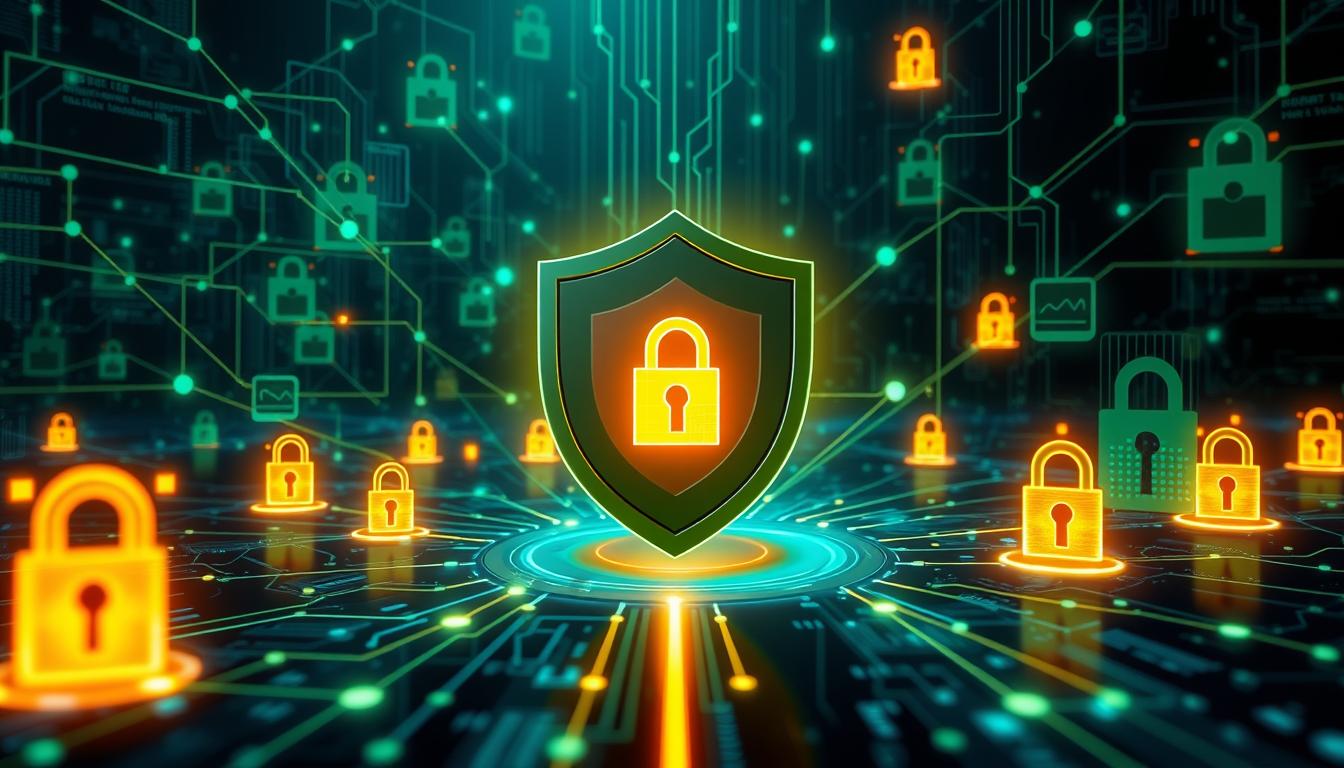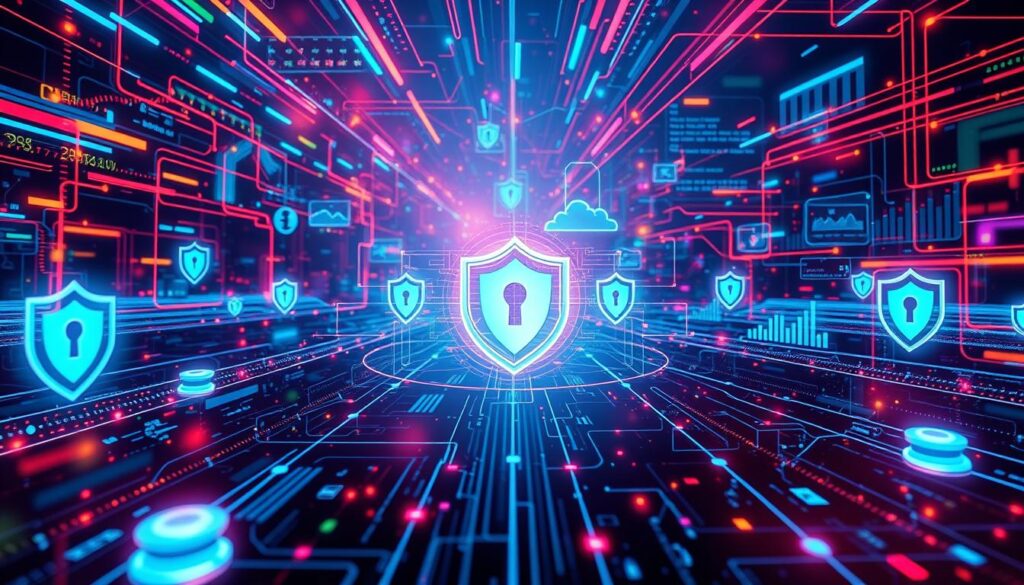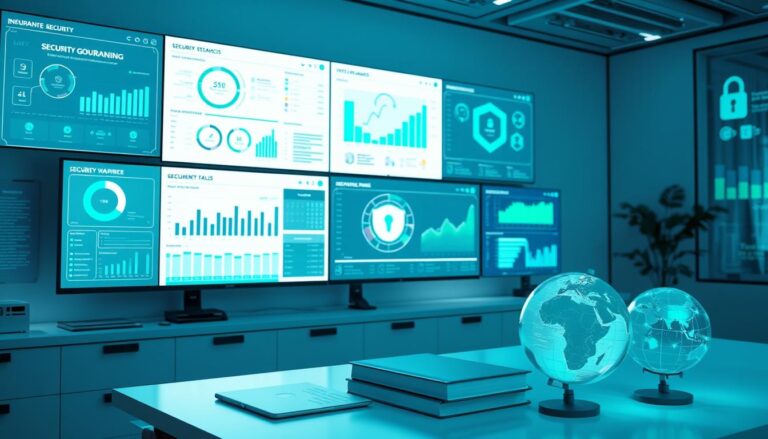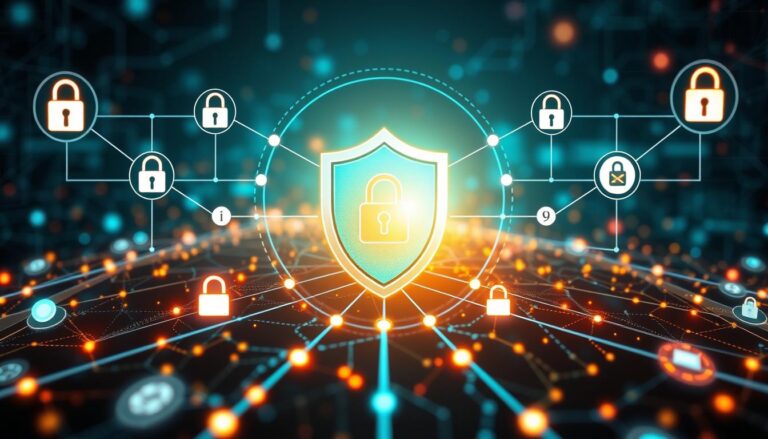
In early 2024, companies faced an average of 1,308 cyberattacks each week. This number jumped by 28% from just a few months before. Cybercrime cost the global economy $12.8 billion in 2023. This shows how critical it is for companies to use strong information security governance risk management strategies.
The need for solid risk management in cybersecurity is clear. The National Institute of Standards and Technology (NIST) says managing cyber risks is an ongoing, iterative process. This is key for spotting and handling threats, helping companies stay safe in the cyber world.
We will explore strategies to boost your organization’s defenses against threats. By using a complete risk management framework, you can strengthen your cybersecurity. This also helps build customer loyalty, increase investor trust, and improve your market image. Effective risk management is like wearing a bulletproof vest—it helps absorb attacks and reduces damage from data breaches and fines.
Introduction to Information Security Governance
Information security governance is key in any organization. It makes sure security goals match the business plan. This framework gives direction, helping in managing risks well.
It’s vital to have a good governance structure. Without it, 40% of companies face more cyber threats. But, with strong risk management, data breaches can drop by 30%.
Linking governance with risk management is a must. It helps manage risks and use resources better. With 87% of leaders focusing on risk, a solid governance is needed more than ever.
Companies with good governance handle risks better, improving by 50%. Aligning security with business goals boosts trust by 40%. This shows how important it is to include information security governance in your strategy.
Understanding Risk Management in Information Security
Risk management is key to good information security governance. As cyber threats grow, companies must update their security plans. It’s not about removing all risks, but about matching security with what’s acceptable for the business.
This approach helps businesses deal with information security risks better.
The Importance of Risk Management
Today, companies face more scrutiny over their information security management. Big data breaches show how vital good risk management is. To keep data safe, companies need strong data protection plans.
A simple formula shows why: Risk = (threat x vulnerability (exploit likelihood x exploit impact) x asset value) – security controls. It shows the need to identify and assess risks from different technologies and processes.
Key Components of Information Security Risk Management
Good information security risk management has several key parts. These include:
- Risk Identification: Spotting possible vulnerabilities and threats helps organizations plan a good response.
- Risk Assessment: Looking at the chance and impact of risks helps focus on what to do first.
- Risk Treatment: Choosing strategies like fixing, passing off, or accepting risks to fit with the company’s goals.
- Continuous Monitoring: Keeping an eye on controls is key, as new risks can pop up with new tech.
A solid risk management framework helps make better decisions and plan for the future. Getting everyone involved in this process helps share information and responsibility. With stricter rules, a clear risk management plan is more important than ever.
| Risk Management Component | Description |
|---|---|
| Risk Identification | Spotting vulnerabilities and threats in the IT world to guide further actions. |
| Risk Assessment | Looking at the chance and possible damage of risks on the company’s work. |
| Risk Treatment | Using strategies like fixing and passing off to deal with risks. |
| Continuous Monitoring | Regularly checking and updating security controls to keep up with changing risks. |
Information Security Governance Risk Management
Understanding information security governance is key for protecting data and following laws. It focuses on managing cybersecurity risks through oversight and structure. This approach aligns security programs with the company’s overall goals.
Defining Information Security Governance
Information security governance is about managing cybersecurity risks through a strategic framework. It makes sure security policies match the company’s mission. A good strategy protects data and improves risk management and crisis response.
Components of Effective Governance Frameworks
To create strong governance frameworks, focus on these key areas:
- Security Program Oversight: Having leaders oversee security ensures a structured approach to managing policies.
- Strategic Alignment: Aligning security with business goals helps create a security-focused culture. It makes departments work together better.
- Risk Assessment Methodologies: Using methods to identify and prioritize risks helps use resources wisely.
- Compliance Integration: Governance frameworks should work with compliance standards. This helps navigate complex rules.
Companies with good governance frameworks see fewer data breaches and cyber threats. With 85% of breaches caused by employee actions, strong oversight is vital. A proactive governance approach is essential to avoid increased risk and security issues.
Risk Assessment Methodology
Effective risk assessment is key for cybersecurity in organizations. It helps identify threats and vulnerabilities. This is important because the world of information security keeps changing.
Companies face many risks, as shown in PwC’s 2022 Pulse Survey. They listed 11 types of risks, including cyber and regulatory ones. There are two main ways to assess risks: qualitative and quantitative.
- Qualitative Risk Analysis: This method uses scenarios to understand risks without numbers.
- Quantitative Risk Analysis: It uses numbers to measure risk severity based on asset value and threat frequency.
Many companies use a mix of both methods. This gives them a wide view of risks. For example, asset-based assessments involve making an inventory and analyzing risks. Vulnerability-based assessments focus on known weaknesses.
Calculating risk involves multiplying the impact by its probability. This gives a clear score. With more third-party vendors, the need for strict methods grows. Tools like security ratings help monitor vendor risks.

Without a single standard, many turn to experts for risk assessments. But, some are moving to manage risks internally to save costs. It’s also important to have clear security policies, like using vendors with SOC 2 assurance.
Good risk assessment helps companies use resources wisely. It’s a key part of a strong information security plan.
Identifying and Analyzing Risks
Identifying and analyzing risks is key to a strong information security plan. By using systematic risk identification techniques, you can find vulnerabilities that could harm your organization. Understanding the risk landscape helps in creating strong risk prevention strategies.
Risk Identification Techniques
Organizations should use different risk identification techniques to manage risks well. Some common methods include:
- Threat Modeling: This method helps predict threats to your information assets and how they might be used.
- Vulnerability Scanning: Tools scan for known vulnerabilities in systems, networks, and apps, helping you focus on urgent issues.
- Asset Classification: Categorizing assets by their importance helps tailor threat analysis to your business needs.
These methods help in a thorough vulnerability assessment, ensuring all threats are managed well.
Identifying Vulnerabilities and Threats
Spotting vulnerabilities is essential for good risk management. Human error causes up to 90% of data breaches, showing the need for strong employee training. Insider threats also pose a big risk, happening in 25% to 30% of cases. Regular checks and updates of security controls ensure compliance with laws like FISMA, HIPAA, and GDPR.
Having a risk-based cybersecurity program can greatly lower the cost of data breaches, which averaged $4.24 million in 2021. Identifying threats well lets organizations put in place necessary controls and prepare for security incidents.
| Aspect | Importance | Impact |
|---|---|---|
| Regular Risk Assessments | Identify vulnerabilities and threats | Reduce unidentified threats by up to 50% |
| Employee Training | Address human error vulnerabilities | Prevent over 90% of data breaches |
| Threat Analysis | Anticipate possible attacks | Improve readiness and incident response |
| Technical Controls | Protect information assets | Lessen cyber threat impact |
| Incident Response Plans | Quickly restore operations | Lessen downtime |
By identifying vulnerabilities through thorough threat identification, you strengthen your organization’s defenses. This leads to a safer information governance framework.
Developing Risk Mitigation Strategies
Managing cybersecurity risks needs effective strategies that fit your organization’s needs. It’s key to know the difference between remediation and risk mitigation. Choosing the right risk management approaches is vital to tackle vulnerabilities and protect your organization for the long term.
Remediation versus Mitigation
Remediation aims to fix vulnerabilities completely. Risk mitigation, on the other hand, uses controls to lessen threat exposure. For instance, if a software flaw is found, you can either fix it fully or use security tools like firewalls and intrusion detection systems.
The choice depends on your resources, urgency, and the risk’s impact on your organization. Using proactive risk management can cut data breaches by 30%. This shows how effective these strategies can be.
Transference and Acceptance Strategies
Risk transference and acceptance are key in risk management. Transference means using insurance to protect against big financial losses. Data shows this can reduce financial exposure by 45% in case of data breaches.
Risk acceptance is about accepting risks that fit within your organization’s risk appetite. Companies might choose to accept risks if the loss is small or the cost to mitigate it is too high. Knowing your risk acceptance limits is critical for effective risk management.
Implementing Security Policies
Security policies are key to protecting your organization from threats. It’s important to make sure these policies match your business goals. This way, you get better protection and smoother operations. Good governance means everyone works together to keep your data safe.
Aligning Policies with Business Goals
Understanding how security policies help your business is the first step. Custom security policies help your company stay secure while reaching its goals. When the executive team gets involved, everyone works together to follow rules and manage risks. This makes your business safer and more efficient.
Compliance Management Solutions Overview
Dealing with security laws is complex, but you can use special tools to help. These tools make sure your company follows the rules, avoiding big fines. Using tools like Centraleyes makes it easier to stay compliant. This keeps your business safe from online threats and protects your reputation.
| Policy Area | Importance | Compliance Requirement | Recommended Action |
|---|---|---|---|
| Access Control | Prevents unauthorized access to sensitive data | HIPAA, GDPR | Regular audits and updates |
| Data Protection | Safeguards against data breaches | GDPR, CCPA | Implement encryption and monitoring |
| Incident Response | Facilitates quick recovery from breaches | NIST CSF | Conduct tabletop exercises |
| Training and Awareness | Reduces human error in cybersecurity | PCI DSS | Implement ongoing training programs |
Monitoring and Reviewing Risk Management Processes
In the world of information security, keeping an eye on risk management is key. Setting up specific KPIs for security checks gives you clear data on how well you’re doing. These KPIs let you see how your security stacks up against your goals. This way, you can make quick changes to face new threats.
Key Performance Indicators for Security Assessment
KPIs are the heart of checking how well risk management works. Studies show that using risk management tools can help spot risks 25% better than doing it by hand. Digital tools can also cut down risk checking time by 40%.
- 70% of businesses mainly use qualitative checks for non-money risks like legal and environmental issues.
- 85% of financial companies prefer quantitative checks, using numbers for clear evaluations.
- Using automated tools, 50% more businesses can see risks in real-time, thanks to constant updates.
More than half of businesses say they’ve lost a lot of money because they didn’t watch their risks closely enough. Doing risk checks at least every three months can cut down on problems by 30%. This shows how important it is to keep checking and improving.
Continuous Improvement Practices
Improving risk management is always needed. Companies with strong plans are three times more likely to bounce back from surprises. Regular checks help improve following rules and boost security, lowering risks to operations and reputation.
The risk management process includes steps like finding risks, analyzing them, setting controls, and watching them closely. Keeping a risk register helps make sure everyone knows their part in fixing problems. About 60% of companies say human mistakes are a big reason for risk failures. Using automated tools can help fix these problems by improving communication and oversight.

Governance Risk and Compliance Tools
The world of governance, risk management, and compliance (GRC) is always changing. This makes it key for companies to use good GRC tools. These tools help manage risks and follow rules better. They are important for keeping costs down.
Popular Tools and Platforms
There are many GRC tools out there, each with its own special features. They help companies deal with tough compliance issues. Some top platforms include:
- MetricStream – It’s a top choice for GRC solutions, with great IT/Cyber Risk Management and a detailed plan for the future.
- RSA Archer – It’s easy to use and helps keep an eye on risks in the company.
- LogicManager – It focuses on finding and fixing risks with new ways to follow rules that fit business needs.
- ServiceNow – It connects risk management with IT operations, making things run smoothly and follow rules better.
Choosing the Right Tools for Your Organization
When picking risk management tools, think about a few things:
- Understanding organizational needs – Know what rules you need to follow, like HIPAA for health care and GDPR for data.
- Scalability – Make sure the tools can grow with your company and keep up with new rules.
- Integration capabilities – Choose tools that work well with what you already have to make following rules easier.
- AI and analytics features – Use tools with AI to watch risks closely and handle rule changes automatically.
- User interface and collaboration – Pick platforms that are easy to use and help teams work together better.
Being good at GRC can make your company better at managing risks. This can save money and make things more efficient. In today’s world, it’s important for companies to have strong GRC plans to handle both rules and operations.
Regulatory Compliance Requirements for Information Security
Today, companies face a complex world of information security rules. It’s key to follow these rules well to manage risks. Laws like HIPAA, GDPR, and FISMA set standards to protect data and prevent breaches.
Understanding Key Regulations
The Health Insurance Portability and Accountability Act (HIPAA) sets strict rules for U.S. healthcare groups. It makes sure health info stays private and safe. The General Data Protection Regulation (GDPR) also has big rules for EU/EEA companies, focusing on data consent.
The Federal Information Security Management Act (FISMA) has rules for federal systems, focusing on risk management. The Payment Card Industry Data Security Standard (PCI-DSS) has 12 key rules for companies that handle credit card info.
Ensuring Compliance in Your Organization
To keep your company in line, you need a solid plan. Check your practices against the rules often. Training your team helps build a strong security culture.
Regular checks and audits are key to staying compliant. They find any issues and help manage risks. Not following the rules can lead to big fines, so staying on top of compliance is critical.
A dedicated compliance team is essential, no matter your company size. They help navigate the complex world of rules. By always improving based on audits, your security program gets stronger against new threats.
Conclusion
In today’s world, keeping your data safe is key. This means having good information security governance and risk management. It’s like having a shield against cyber threats.
Studies show that using the NIST Cybersecurity Framework can really help. It can make your risk management 30% better. This is important for keeping your data safe in a world that’s always changing.
Ignoring your data’s safety can cost a lot. On average, a data breach costs $3.86 million. Without a solid risk management plan, you’re more likely to get hacked, with a 29% chance.
By always updating your risk management, you can make your cybersecurity stronger. This lowers your risk and makes people trust you more.
Also, teaching your employees about cybersecurity is very important. Most breaches happen because of mistakes people make. Good training can make your team more careful and ready for threats.
Having a strong governance framework is also key. It helps create a culture of safety and compliance. This way, your team can handle changes and stay safe from cyber threats.
As the cyber world keeps changing, staying ahead is important. Being proactive in your cybersecurity efforts will help you deal with today’s risks.
Source Links
- Understand the Importance of Cybersecurity Risk Management
- Developing an Information Security and Risk Management Strategy
- What is Information Security Governance ?
- Governance of Information Security
- What is Information Security Governance?
- Information Security Risk Management (ISRM) | Rapid7
- How Security Governance Can Help Protect You from Cyberthreats
- What is Information Risk Management?
- What Is Information Security Governance?
- CSC 210 Information Security Governance, Risk Management and Asset Security
- What is GRC? The rising importance of governance, risk, and compliance
- 7 risk assessment methodologies and tips to choosing one | Vanta
- IT Security Risk Assessment Methodology: Qualitative vs Quantitative | UpGuard
- What Is Information Security Governance in Cybersecurity?
- Cybersecurity Risk Management | Frameworks, Analysis & Assessment | Imperva
- 6 Steps for Developing Effective Risk Management Strategies | LogicGate Risk Cloud
- Unlocking the Benefits of Information Security Governance and Risk Management
- Understanding information security governance
- Creating an Information Security Policy Framework: A 5 steps guide
- What is Cyber Risk Governance? Implementing Cyber Strategy | UpGuard
- Five Steps of Risk Management Process 2025
- Risk Management 101: Process, Examples, Strategies | AuditBoard
- What is GRC? – Governance, Risk, and Compliance Explained – AWS
- Top 5 Governance, Risk, and Compliance (GRC) Tools and Solutions for 2025
- Cybersecurity compliance: What you need to know
- Information Security Governance, Risk and Compliance team
- Information Security Governance Roles and Responsibilities
- GRC in Cybersecurity: What Is It, Importance & Challenges



